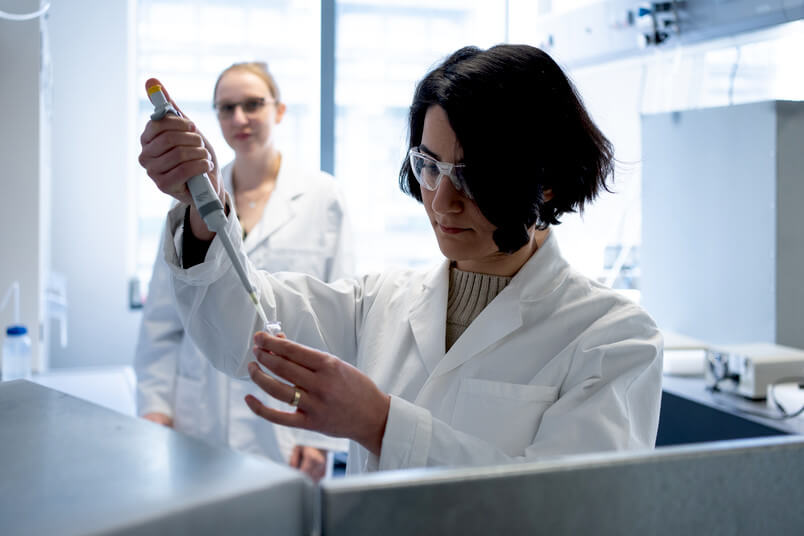- Ruhr-Universität Bochum

Dr. Mahnaz Azimzadeh Sani and Dr. Julia Linnemann (from right) are part of the team that found unexpectedly high electrochemical capacities on individual gold and platinum nanoparticles.
© RUB, Kramer
Where Water Meets Metal
Researchers from the RESOLV Cluster of Excellence have used current and voltage measurements on individual nanoparticles to determine that the capacitively stored charge at platinum interfaces can be significantly higher than previously thought. They attribute this to a special arrangement and bonding of water molecules. To this end, the international team led by Prof. Dr. Kristina Tschulik, whose ideas were awarded an ERC Starting Grant from the European Research Council in 2020, cooperated with partners from France and Israel. The authors describe their findings in the journal Angewandte Chemie - online, published Dec. 19, 2021.
Although interfaces between metals and water are the local areas where crucial processes of energy technologies such as water splitting occur, little is known about their structure and changes during such processes. For more than 100 years, the scientific description of such interfaces has been dominated by the model of the so-called electrochemical double layer. It states that charge carriers of an aqueous solution are increasingly arranged in the boundary region to the metal in order to compensate for excess electrical charges on the metal side. In the process, the opposing charges are separated by water molecules. Similar to a technical plate capacitor, this nanoscopic charge separation in the interface allows energy to be stored and retrieved later. Processes in which the molecular structure of the electrochemical double layer changes are relevant to many green technologies, such as supercapacitors and fuel cells.
Nanoparticles, which are thousands of times smaller than the diameter of a human hair, are increasingly being studied for such technical applications. Because of their advantageous ratio of process-relevant surface area to volume, they offer particularly good conditions for this. The Iranian scientist Dr. Mahnaz Azimzadeh Sani, who was funded by the German Academic Exchange Service, used so-called colloidal nanoparticle dispersions. Here, nanoparticles are separated from each other and finely dispersed in aqueous solution and randomly strike a live microelectrode every now and then. With the help of computer-aided molecular dynamics simulations, commonalities and differences of voltage-dependent measured capacitive currents of different types of nanoparticle dispersions could be interpreted. The unexpectedly high capacitances are attributed to dissolved charged particles that increasingly accumulate in interstices of a compact water layer bound to platinum (and more weakly to gold) and an adjacent water layer of a different arrangement.
